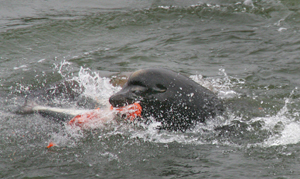No Evidence of Tampering in Last Year’s Sea Lion Deaths at Bonneville

An investigation by NOAA’s Fisheries Service into the deaths last May of six sea lions trapped on two floating cages below Bonneville Dam found no evidence of human intervention, either intentional or accidental, in the closing of the cage doors. Once trapped, the animals likely became overheated and died of physical exertion or stress-induced heat prostration.
This scenario was confirmed within hours of the May 4 incident by biologists and veterinarians who performed necropsies on the animals and subsequently by studies of tissue samples from the animals. Early media reports that one or more of the sea lions may have been shot or poisoned were quickly refuted by necropsy results and X-ray studies by the U.S. Fish and Wildlife Service’s National Forensic Laboratory in Ashland, Ore. NOAA Fisheries said several factors, such as changing river levels, sea lion movements shifting the traps or entanglement of the cage doors’ trip lines, may have contributed to the accidental closing of the doors.
The trapping was part of a federally authorized effort by Washington and Oregon to remove California sea lions that had been identified as having a history of preying on federally protected salmon below the dam. Under their Fisheries Service authorization granted last year, the states trapped and transferred to Sea World aquariums in Texas and Florida six California sea lions in April and early May
Sea lions naturally haul out of the water and rest on structures like jetties or docks. Floating cages are comfortable haul-out sites for sea lions and have for years been used by researchers to attract and humanely trap these animals for a variety of purposes, principally to mark and measure them and to collect biological samples for research, before the animals are released back into the wild. The doors to these traps are left open, allowing any animal to come and go at will. They are closed only when researchers visit the traps to carry out their research.The agency said that because of the Bonneville incident the states are making changes to all trapping practices to ensure that cage doors are securely locked when they are left open and can be closed only when researchers are present and can monitor and quickly examine and release any trapped sea lions.
The authorization for the two states to trap and permanently remove California sea lions was suspended last May as part of an agreement among NOAA’s Fisheries Service, the states, and the Humane Society of the United States, which is suing the agency over the legality of the authorization. That suspension expires March 1, when the states expect to begin trapping and permanent removal again.NOAA understands and predicts changes in the Earth's environment, from the depths of the ocean to the surface of the sun, and conserves and manages our coastal and marine resources.
 Deep Sea Crabs
Deep Sea Crabs